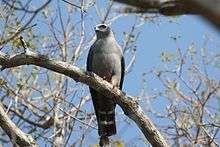Plumbeous kite
| Plumbeous kite | |
|---|---|
 | |
| In Mato Grosso do Sul, Brazil | |
| Scientific classification | |
| Kingdom: | Animalia |
| Phylum: | Chordata |
| Class: | Aves |
| Order: | Accipitriformes |
| Family: | Accipitridae |
| Genus: | Ictinia |
| Species: | I. plumbea |
| Binomial name | |
| Ictinia plumbea Gmelin, 1788 | |
The plumbeous kite (Ictinia plumbea) is a bird of prey in the family Accipitridae.
The plumbeous kite breeds in the neotropic ecozone, from eastern Mexico to Peru, Bolivia and Argentina. It also breeds on Trinidad. Birds in the north and south of the breeding range, including the populations in Central America, Trinidad, Venezuela and Colombia, and southern Argentina and Brazil, are migratory, moving into tropical South America in the northern winter.
This is a bird of lowland forest and savannah, which builds a stick nest in a tree and lays 1-2 blue-white eggs. It is typically 33–38 cm (13–15 in) long and weighs 190-280g (6.7-10 oz). It is not particularly gregarious, although it is often seen in flocks during migration.
The plumbeous kite has long, pointed wings. Adults are mainly slate-grey, with a paler head and underparts. The short black tail has 2-3 white bands. The eyes are red and the legs are orange. In flight, this kite shows a rufous primary patch.
Sexes are similar, but immature birds have white-streaked grey upperparts and dark-streaked whitish underparts. They lack the rufous wing patch. The call of plumbeous kite is a whistled si-see-oo.
The flight is slow, with frequent glides, and the prey is almost exclusively insects taken in the air. This kite often perches conspicuously on dead branches, with its long wings projecting well beyond the tail.
References
- ↑ BirdLife International (2012). "Ictinia plumbea". IUCN Red List of Threatened Species. Version 2013.2. International Union for Conservation of Nature. Retrieved 26 November 2013.
- Hilty, Steven L (2003). Birds of Venezuela. London: Christopher Helm. ISBN 0-7136-6418-5.
- ffrench, Richard (1991). A Guide to the Birds of Trinidad and Tobago (2nd ed.). Comstock Publishing. ISBN 0-8014-9792-2.
External links
| Wikimedia Commons has media related to Cercomacra melanaria. |
- Plumbeous Kite videos on the Internet Bird Collection
- Plumbeous Kite photo gallery VIREO Photo-High Res
